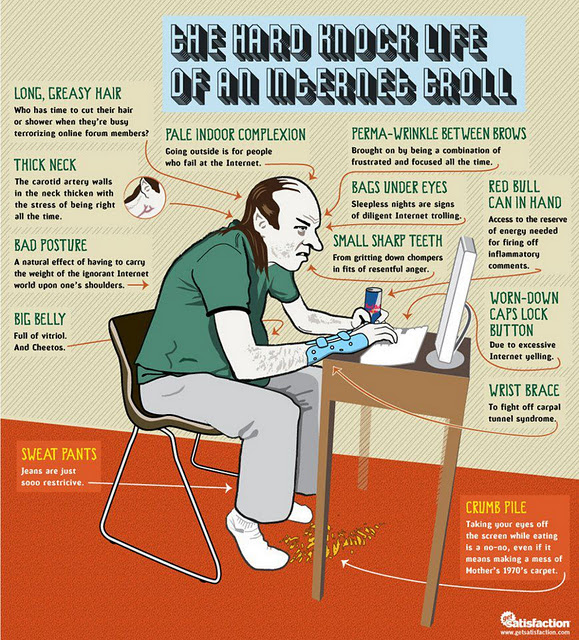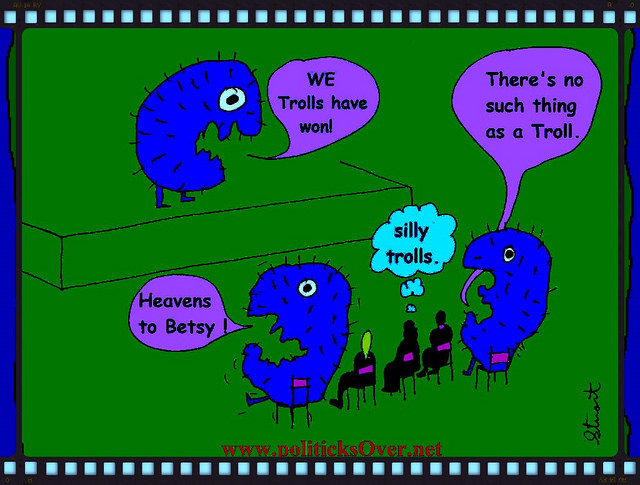Internet Trolls: Why they never really went away… at all
If you had the chance to do something so bad, with the assurance that no one will ever know you did it, will you do it? More so, if you were to gain popularity from doing a bad thing without ever getting caught or punished, will you be more encouraged to do it?
The psychology of the human person is that which pushes the boundaries of ethics. Performance artist, Marina Abramovi? explored this in her controversial piece called Rhythm 0 in 1974, where she had given the audience freedom to do anything they want with her body using any of the 72 objects on a table. These included a rose, a feather, bread, grapes, perfume, wine, a pair of scissors, a scalpel, a metal bar, and finally, a gun loaded with one bullet.
How things transpired in that performance was quite revealing to how humans get in touch with their dark side. An art critic who was present in the event wrote that at the start, the audience was very tame. They moved her arms and gave her a rose. Some tried to touch her intimately. As the night drew on, other people started to do harsher things. They ripped her clothes with a razor, someone slit her throat to drink her blood, and she was stripped naked. This was done to her knowing that she will remain passive throughout the performance. Abramovic’s cause reached a climax when someone pointed the gun through her head and part of the audience stopped that person. A fight amongst the audience happened after that. When the performance was done and she finally moved, the audience ran away avoiding confrontation.

Trolls and their dark traits
This anecdote from Abramovi’s social experiment is a critical insight as to how the so-called “Internet trolls” behave and exist. In a study done by a group of Canadian researchers in 2014, they found out three common characteristics amongst “trolls”: narcissism, psychopathy, and even sadism. Two online studies covered 1,200 people where researchers looked into their personality tests and commenting behavior. Some claim that 6.5 percent of people who comment online are Internet trolls.
The research claimed that Internet trolls find sadistic glee in distressing other people. The disrupting and argumentative comments they throw in online forums and social media feed their hidden desires. These people need not be the losers who hide in their parents’ basements. Strikingly, trolls can be anybody. In fact, it can easily be all of us, because in a sense, we all have dark sides. But as rational human beings, we do not just succumb to our desires as we have the power and capacity to make a choice. And the choice to troll or not to troll is in our hands.
Just like in the Abramovi? experiment, the threshold that divided the audience was when a gun was toted against her. To take her life was the objectionable action that divided them. In this aspect, the value of life prevailed. But as to why some people decided to hurt her and even slit her throat? It’s the same question that could be thrown at Internet trolls.
A wild wild Internet

But these three dark traits are not the only factors that add fuel to the fire. Troll prevalence in the Internet is mainly due to the lack of regulations. Freedom of speech is the only sacred rule or value online. Anybody can say what they want to say and not be ultimately held accountable for it. That is why Internet trolling is thriving. For example, the hate statements against Duterte supporters and vise versa, have been growing more and more in 2016. And has anyone been arrested for saying “Dutertard”? Or would anyone be really subjected to shame and punishment if someone says he or she is amused by the recent Davao blast? Not really. And trolling won’t be dying anytime soon because of the current environment of the Internet.
Remember that the Internet allows you to take on a different persona, someone whom you can detach from your physical self. We can create an alter-ego online. We can be mild and sweet in person, but we can also portray a sexual maniac persona online. And trolling is one example of that.
The case of Leslie Jones for example caused a lot of ruckus mainly because the Ghostbusters star became the object of ridicule by some trolls. Racial slurs and offending comments flooded her Twitter page causing her to quit the social media site and file a complaint. Twitter, on the other hand, did not take this case sitting down this time. In the past, the social media site has been known to be passive in regulating, reprimanding, and banning trolls. This one however, stirred so much controversy that Twitter outrightly banned one of the trolls, the infamous Milo Yiannopoulos.
Trolls in the Philippine context
In our culture, trolls prevail just the same as we maintain a sense of pakikisama. We don’t blatantly disagree with someone as frankness is too Western of a value. Instead, we gossip or backstab someone. We can put a smiley face on, even if we rant about life in our social media accounts. And the internet is a perfect space where pakikisama need not apply. To talk about unity on the internet will just frustrate anyone, as it is every man for himself in the virtual world.
Though there are local laws that attempt to regulate the misconduct done within the realm of the internet (e.g. RA10175 or the Cybercrime Prevention Act of 2012), it does not curtail the freedom enjoyed by trolls and hatemongers. In fact, the “business-minded” people even try to monetize trolling. There is money made in this and people are willing to take it. Interestingly, some even use trolling to promote products or push forward political advocacies.
In an Inquirer article, one troll confessed that he was trolling as a part of his PR job. He gets paid to troll and the act itself is even utilized as a plan for advertising. Most often than not, trolls are even just made up personalities made to believe that they exist in real life. Bashers, who are another form of trolls, have also been used to discredit certain celebrities or influencers. Politicians use troll tactics to topple their competitors. Just look back at the 2016 Philippine Presidential Elections and you will see the amount of trolling activity that has happened.

So is there a way to make these trolls go away?
Not really. They represent a dark side of humanity and the Internet is only reflecting it back to us. Franco Mabanta, a local celebrity, took his frustrations over trolls on his Facebook page and said that netizens actually give trolls what they want – attention. People get so furious with their statements that replying to them in anger feels so irresistible. And that’s what they want. That’s what keeps them alive and kicking. It is the distress of people that feeds them.
But for the sake of our own sanity, we can choose to ignore them altogether (or wait until an Internet justice system is established.) They’ve been there since the Internet began, but we’ve got to start ignoring them if we want to give them one less reason to keep trolling.
We can also choose to respond to them, though the response could either empower trolls more or actually weaken them. Trolls won’t usually waste their time in intellectual discourse; they hate that. What they do is post nasty one-liners or just anything to bring in the “lulz”. Given the way they operate, responding in the most unexpected way will actually kill them. Avoid emotionally charged statements and stick to objective ones. The less emotions the better, as trolls will feed on these emotions to annoy people. They will never feed on logic and sensibility as that is the opposite of what they want to do.
This post is supported by a writing grant from the Philippine Center for Investigative Journalism (PCIJ)


